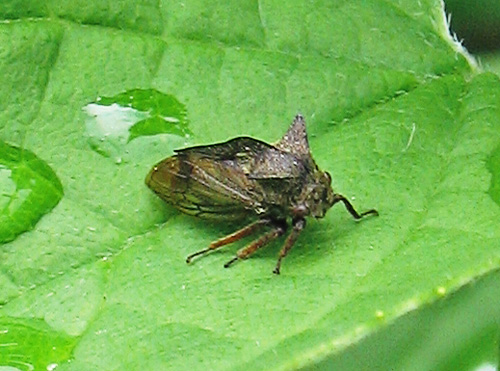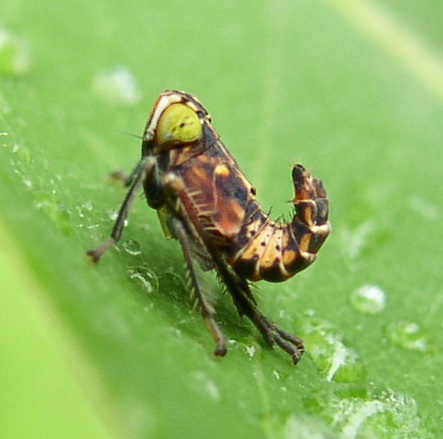|
Homoptera
Homoptera is a suborder of order Hemiptera that is considered by some taxonomists to be paraphyly, paraphyletic, and therefore Deprecation, deprecated (obsolete). It was therefore split into the suborders Sternorrhyncha, Auchenorrhyncha, and Coleorrhyncha. The earlier work was based on nuclear DNA, but more recent phylogenetic analysis using mitochondrial DNA suggest that Homoptera may be a monophyletic group after all, a sister group of Heteroptera. The cause of the disparity in the analyses is suggested to be the long branch attraction effect in phylogenetic analysis, due to rapidly evolving DNA regions. The Homoptera include the aphids, scale insects, cicadas, and leafhoppers, which all have sucking mouthparts. References Insect suborders Hemiptera {{Hemiptera-stub ... [...More Info...] [...Related Items...] OR: [Wikipedia] [Google] [Baidu] |
Aphids
Aphids are small sap-sucking insects and members of the superfamily Aphidoidea. Common names include greenfly and blackfly, although individuals within a species can vary widely in color. The group includes the fluffy white woolly aphids. A typical life cycle involves flightless females giving live birth to female nymphs—who may also be already pregnant, an adaptation scientists call telescoping generations—without the involvement of males. Maturing rapidly, females breed profusely so that the number of these insects multiplies quickly. Winged females may develop later in the season, allowing the insects to colonize new plants. In temperate regions, a phase of sexual reproduction occurs in the autumn, with the insects often overwintering as eggs. The life cycle of some species involves an alternation between two species of host plants, for example between an annual crop and a woody plant. Some species feed on only one type of plant, while others are generalists, coloni ... [...More Info...] [...Related Items...] OR: [Wikipedia] [Google] [Baidu] |
Hemiptera
Hemiptera (; ) is an order (biology), order of insects, commonly called true bugs, comprising over 80,000 species within groups such as the cicadas, aphids, planthoppers, leafhoppers, Reduviidae, assassin bugs, Cimex, bed bugs, and shield bugs. They range in size from to around , and share a common arrangement of piercing-sucking Insect mouthparts, mouthparts. The name "true bugs" is often limited to the suborder Heteroptera. Entomologists reserve the term ''bug'' for Hemiptera or Heteroptera,Gilbert Waldbauer. ''The Handy Bug Answer Book.'' Visible Ink, 1998p. 1. which does not include other arthropods or insects of other orders such as Ant, ants, Bee, bees, Beetle, beetles, or Butterfly, butterflies. In some variations of English, all Terrestrial animal, terrestrial arthropods (including non-insect arachnids, and myriapods) also fall under the Colloquialism, colloquial understanding of ''bug''. Many insects with "bug" in their common name, especially in American English, belo ... [...More Info...] [...Related Items...] OR: [Wikipedia] [Google] [Baidu] |
Leafhoppers
A leafhopper is the common name for any species from the family Cicadellidae. These minute insects, colloquially known as hoppers, are plant feeders that suck plant sap from grass, shrubs, or trees. Their hind legs are modified for jumping, and are covered with hairs that facilitate the spreading of a secretion over their bodies that acts as a water repellent and carrier of pheromones. They undergo a partial metamorphosis, and have various host associations, varying from very generalized to very specific. Some species have a cosmopolitan distribution, or occur throughout the temperate and tropical regions. Some are pests or vectors of plant viruses and phytoplasmas. The family is distributed all over the world, and constitutes the second-largest hemipteran family, with at least 20,000 described species. They belong to a lineage traditionally treated as infraorder Cicadomorpha in the suborder Auchenorrhyncha, but as the latter taxon is probably not monophyletic, many m ... [...More Info...] [...Related Items...] OR: [Wikipedia] [Google] [Baidu] |
Auchenorrhyncha
The Auchenorrhyncha suborder of the Hemiptera contains most of the familiar members of what was called the "Homoptera" – groups such as cicadas, leafhoppers, treehoppers, planthoppers, and spittlebugs. The aphids and scale insects are the other well-known "Homoptera", and they are in the suborder Sternorrhyncha. Distributed worldwide, all members of this group are plant-feeders, and many are vectors of viral and fungal diseases of plants. It is also common for Auchenorrhyncha species to produce either audible sounds or substrate vibrations as a form of communication. Such calls range from vibrations inaudible to humans, to the calls of many species of cicadas that can be heard for hundreds of metres, at least. In season, they produce the most characteristic and ubiquitous noise of the bush. Etymology The word auchenorrhyncha is from the Greek αὐχήν, 'neck, throat' and ῥύγχος, 'snout'. Classification Debate and uncertainty as to whether the Auchenorrhync ... [...More Info...] [...Related Items...] OR: [Wikipedia] [Google] [Baidu] |
Insect Suborders
Insects (from Latin ') are pancrustacean hexapod invertebrates of the class Insecta. They are the largest group within the arthropod phylum. Insects have a chitinous exoskeleton, a three-part body (head, thorax and abdomen), three pairs of jointed legs, compound eyes and one pair of antennae. Their blood is not totally contained in vessels; some circulates in an open cavity known as the haemocoel. Insects are the most diverse group of animals; they include more than a million described species and represent more than half of all known living organisms. The total number of extant species is estimated at between six and ten million; In: potentially over 90% of the animal life forms on Earth are insects. Insects may be found in nearly all environments, although only a small number of species reside in the oceans, which are dominated by another arthropod group, crustaceans, which recent research has indicated insects are nested within. Nearly all insects hatch from ... [...More Info...] [...Related Items...] OR: [Wikipedia] [Google] [Baidu] |
Cicada
The cicadas () are a superfamily, the Cicadoidea, of insects in the order Hemiptera (true bugs). They are in the suborder Auchenorrhyncha, along with smaller jumping bugs such as leafhoppers and froghoppers. The superfamily is divided into two families, the Tettigarctidae, with two species in Australia, and the Cicadidae, with more than 3,000 species described from around the world; many species remain undescribed. Cicadas have prominent eyes set wide apart, short antennae, and membranous front wings. They have an exceptionally loud song, produced in most species by the rapid buckling and unbuckling of drumlike tymbals. The earliest known fossil Cicadomorpha appeared in the Upper Permian period; extant species occur all around the world in temperate to tropical climates. They typically live in trees, feeding on watery sap from xylem tissue, and laying their eggs in a slit in the bark. Most cicadas are cryptic. The vast majority of species are active during the day as adults, ... [...More Info...] [...Related Items...] OR: [Wikipedia] [Google] [Baidu] |
Heteroptera
The Heteroptera are a group of about 40,000 species of insects in the order Hemiptera. They are sometimes called "true bugs", though that name more commonly refers to the Hemiptera as a whole. "Typical bugs" might be used as a more unequivocal alternative, since the heteropterans are most consistently and universally termed "bugs" among the Hemiptera. "Heteroptera" is Greek for "different wings": most species have forewings with both membranous and hardened portions (called hemelytra); members of the primitive sub-group Enicocephalomorpha have completely membranous wings. The name "Heteroptera" is used in two very different ways in modern classifications. In Linnean nomenclature, it commonly appears as a suborder within the order Hemiptera, where it can be paraphyletic or monophyletic depending on its delimitation. In phylogenetic nomenclature, it is used as an unranked clade within the Prosorrhyncha clade, which in turn is in the Hemiptera clade. This results from the realiza ... [...More Info...] [...Related Items...] OR: [Wikipedia] [Google] [Baidu] |
Sternorrhyncha
The Sternorrhyncha suborder of the Hemiptera contains the aphids, whiteflies, and scale insects, groups which were traditionally included in the now-obsolete order "Homoptera". "Sternorrhyncha" refers to the rearward position of the mouthparts relative to the head. Distributed worldwide, all members of this group are plant-feeders, many considered pests feeding on major crops and ornamental plants. Many exhibit modified morphology and/or life cycles, including phenomena such as flightless morphs, parthenogenesis, sexual dimorphism, and eusociality. Phylogeny The phylogeny of the extant Sternorrhyncha, inferred from analysis of small subunit (18S) ribosomal RNA, is shown in the cladogram. The evolutionary position of several fossil taxa are unclear. A suggested phylogeny is: Groups Well-known groups in the Sternorrhyncha include: * aphids – (Aphididae) * woolly and gall-making aphids (Eriosomatinae) * pine and spruce aphids (Adelgidae) * phylloxerans (Phylloxeridae, ... [...More Info...] [...Related Items...] OR: [Wikipedia] [Google] [Baidu] |
Coleorrhyncha
Coleorrhyncha or Peloridiomorpha, also known as moss bugs or beetle bugs, are a suborder of Hemiptera and represent an ancient lineage of moss-feeding insects. They show some similarities to the Heteroptera but have been considered distinct. It has a single extant family, the Peloridiidae. They are in length, and feed on moss and liverworts. They have wings in some species which are reduced in others but all species are flightless and live in damp moss habitats and are associated with the distribution of ''Nothofagus'' trees in Australia, New Zealand, New Caledonia, and South America, which all were formerly part of the supercontinent Gondwana. Three other major families have been established on the basis of fossils: Progonocimicidae (Late Permian to Late Cretaceous) Karabasiidae (Jurassic-Early Cretaceous) and Hoploridiidae (Early Cretaceous), which have been found in both the Northern and Southern Hemispheres. The oldest member of Coleorrhyncha is '' Permoridium'' from the ea ... [...More Info...] [...Related Items...] OR: [Wikipedia] [Google] [Baidu] |
Scale Insects
Scale insects are small insects of the order Hemiptera, suborder Sternorrhyncha. Of dramatically variable appearance and extreme sexual dimorphism, they comprise the infraorder Coccomorpha which is considered a more convenient grouping than the superfamily Coccoidea due to taxonomic uncertainties. Adult females typically have soft bodies and no limbs, and are concealed underneath domed scales, extruding quantities of wax for protection. Some species are hermaphroditic, with a combined ovotestis instead of separate ovaries and testes. Males, in the species where they occur, have legs and sometimes wings, and resemble small flies. Scale insects are herbivores, piercing plant tissues with their mouthparts and remaining in one place, feeding on sap. The excess fluid they imbibe is secreted as honeydew on which sooty mold tends to grow. The insects often have a mutualistic relationship with ants, which feed on the honeydew and protect them from predators. There are about 8,000 descr ... [...More Info...] [...Related Items...] OR: [Wikipedia] [Google] [Baidu] |
Long Branch Attraction
In phylogenetics, long branch attraction (LBA) is a form of systematic error whereby distantly related lineages are incorrectly inferred to be closely related. LBA arises when the amount of molecular or morphological change accumulated within a lineage is sufficient to cause that lineage to appear similar (thus closely related) to another long-branched lineage, solely because they have both undergone a large amount of change, rather than because they are related by descent. Such bias is more common when the overall divergence of some taxa results in long branches within a phylogeny. Long branches are often attracted to the base of a phylogenetic tree, because the lineage included to represent an outgroup is often also long-branched. The frequency of true LBA is unclear and often debated, and some authors view it as untestable and therefore irrelevant to empirical phylogenetic inference. Although often viewed as a failing of parsimony-based methodology, LBA could in principle resul ... [...More Info...] [...Related Items...] OR: [Wikipedia] [Google] [Baidu] |








